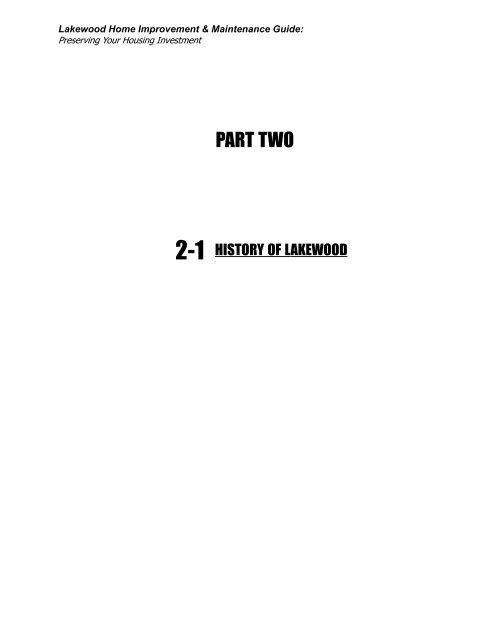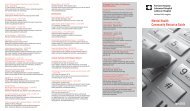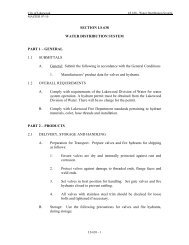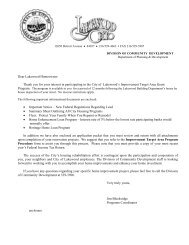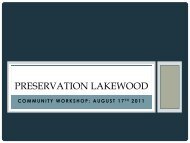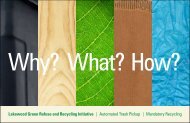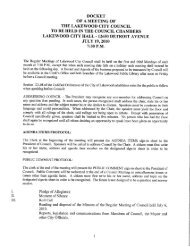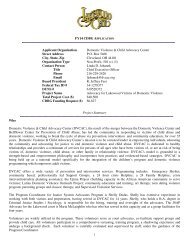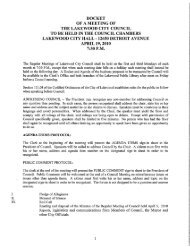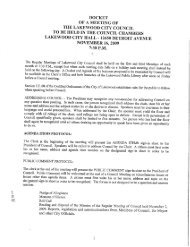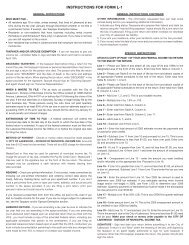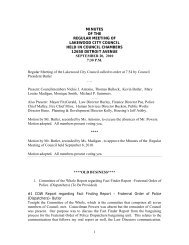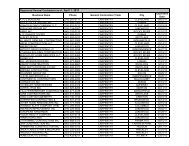2-1 History of Lkwd - City of Lakewood, Ohio
2-1 History of Lkwd - City of Lakewood, Ohio
2-1 History of Lkwd - City of Lakewood, Ohio
Create successful ePaper yourself
Turn your PDF publications into a flip-book with our unique Google optimized e-Paper software.
<strong>Lakewood</strong> Home Improvement & Maintenance Guide:Preserving Your Housing InvestmentPART TWO2-1HISTORY OF LAKEWOOD
<strong>Lakewood</strong> Home Improvement & Maintenance Guide:Preserving Your Housing Investment2-1 <strong>History</strong> <strong>of</strong> <strong>Lakewood</strong>THE EARLY YEARSDifferent types <strong>of</strong> transportation had importantroles in the development <strong>of</strong><strong>Lakewood</strong>. Roads, railroads, and streetcarshave all left their imprint on thecity. This interplay over almost two centurieshas created the <strong>Lakewood</strong> we seetoday, including the patterns <strong>of</strong> buildings.<strong>Lakewood</strong>, the first suburb west <strong>of</strong>Cleveland on the shores <strong>of</strong> Lake Erie,began simply in 1805 as Township 7,Range 14 <strong>of</strong> the Connecticut WesternReserve. It was a wooded wildernessthrough which cut the old Huron PostRoad, which ran from Buffalo to Detroit.In 1819, a small group <strong>of</strong> eighteen familiesliving in the area <strong>of</strong> present-day<strong>Lakewood</strong>, Rocky River, and part <strong>of</strong>Cleveland’s West Park neighborhood,named the growing community RockportTownship. By 1871 the <strong>Lakewood</strong> areawas known as East Rockport. A community<strong>of</strong> farms, orchards, and vineyardsprospered as people came fromNew England and New York, and immigrantsarrived from England, Germany,and later, Eastern Europe. In 1889, EastRockport, with 400 residents, separatedfrom the Township and became thehamlet <strong>of</strong> <strong>Lakewood</strong>. Settlement acceleratedrapidly, with <strong>Lakewood</strong> becominga Village with 3,500 residents in1903. <strong>City</strong> status, with 12,000 residents,came just eight years later. By 1930,the population <strong>of</strong> <strong>Lakewood</strong> was 70,509.ROADS AND TRANSPORTATIONRoads were the earliest influence ondevelopment in <strong>Lakewood</strong>. TheRockport Plank Road Company improvedthe old Detroit Road in 1848,opening a toll road from present-dayWest 25 th Street in Cleveland to fivemiles west <strong>of</strong> the Rocky River. It continuedoperating as a toll road until1901.A series <strong>of</strong> bridges carrying Detroit Avenueover the Rocky River Valley, thefirst <strong>of</strong> which was built in 1821, improvedcommerce between Clevelandand the emerging communities to itswest. An 1874 atlas <strong>of</strong> CuyahogaCounty shows present-day main roadssuch as Detroit Avenue, Madison Avenue,Franklin Boulevard, Hilliard Road,Warren Road, and Riverside Drive, aswell as several other streets.The Rocky River Railroad was organizedin 1869 by speculators as an excursionline to bring Clevelanders to the resortarea they developed at the mouth <strong>of</strong>the Rocky River. Financially unsuccessfulas a pleasure and amusement venture,the line was sold to the NickelPlate Railroad in 1881. The railroadline still exists today, running in an eastwestdirection north <strong>of</strong> Detroit Avenue.51
<strong>Lakewood</strong> Home Improvement & Maintenance Guide:Preserving Your Housing Investment<strong>History</strong> <strong>of</strong> <strong>Lakewood</strong>, continuedThe type <strong>of</strong> transportation most significantto the growth <strong>of</strong> <strong>Lakewood</strong> was the streetcarsystem. The Detroit Avenue line openedin 1893, followed by the Clifton Boulevardline in 1903, and finally the Madison Avenueline in 1916. As the early farms weresubdivided and real estate speculators advertised<strong>Lakewood</strong>’s ideal natural setting byLake Erie, neighborhoods appeared adjacentto the streetcar lines. An interurbanrail system connected <strong>Lakewood</strong> with communitiesfarther west.THE FIVE LANDSCAPES OF LAKEWOODAll <strong>of</strong> these changes created present day<strong>Lakewood</strong>. In their book, <strong>Lakewood</strong>: TheFirst Hundred Years, Jim and SusanBorchert describe five specific landscapesin <strong>Lakewood</strong>.Urban Village - This neighborhood, alongMadison Avenue from West 117 th Street toMadison Park, is <strong>of</strong>ten referred to as Bird’sNest. A subsidiary <strong>of</strong> National Carbon laidout over 400 lots in 1894 as a way to attractworkers to the nearby factory, which did nothave a streetcar connection. Mainly EasternEuropean immigrants built a distinctiveand densely packed neighborhood <strong>of</strong>houses, shops, and churches.Clifton Park and Lakefront Estates -Unable to succeed as a resort area at themouth <strong>of</strong> the Rocky River, the area was developedas an exclusive residential districtbeginning in the late1890’s. Clifton Park wasdesigned to have a park-like setting withcurving streets, which contrasts to the gridpattern <strong>of</strong> the rest <strong>of</strong> <strong>Lakewood</strong>. The neighborhoodbecame home to many <strong>of</strong> GreaterCleveland’s leading industrialists and pr<strong>of</strong>essionals.52Along Lake Avenue, estates stretched fromthe north side <strong>of</strong> the street to Lake Erie,with large houses situated close to the water.Today, only a few <strong>of</strong> the Lake Avenueestates remain.Middle <strong>Lakewood</strong> - These are the familiarstreets <strong>of</strong> single-family and two-familyhomes in <strong>Lakewood</strong>, almost always laid outin a grid pattern, built from the 1890’sthrough the 1920’s. These lots were theresult <strong>of</strong> subdividing larger farms andwoods, with a street added to provide access,and a grid created the most lots.Builders sometimes constructed speculativehousing, <strong>of</strong>ten with several similar or identicalhouses near each other. In other cases,individuals purchased a lot and contractedwith a builder. Because <strong>of</strong> the patchworkdevelopment pattern over several decadesand by many people, features such as thestreet width, lot size, tree lawn depth, anddistance from the curb to the front porch<strong>of</strong>ten vary, <strong>of</strong>ten from street-to-street.Apartment Houses and Cliff Dwellers- Apartment buildings, intended for singles,newly married couples, and small families,were closely linked to the streetcar lines.By 1930, <strong>Lakewood</strong> had about 200 apartmentbuildings. As the streetcar linesopened, most apartments were built alongDetroit and Madison Avenues, or aroundthe corner on side streets. Apartments eitheroccupied the entire building or the floorabove stores. In addition, several clusters<strong>of</strong> larger apartment buildings were constructedduring the 1910’s and 1920’s atthe east end <strong>of</strong> Clifton Boulevard, LakeAvenue, and Edgewater Drive, as well asthe areas around the intersections <strong>of</strong> CliftonBoulevard/Warren Road and Lake Avenue/Cook Avenue.
<strong>Lakewood</strong> Home Improvement & Maintenance Guide:Preserving Your Housing Investment<strong>History</strong> <strong>of</strong> <strong>Lakewood</strong>, continuedCommercial Landscapes - As the mainroad through Rockport Township, Detroit Avenuehas always been a center <strong>of</strong> activity. Afew 19 th century houses remain today, howeverthe streetcar lines ensured that Detroitand Madison Avenues would become the focalpoint <strong>of</strong> commerce and civic life. Hundreds<strong>of</strong> merchants provided daily necessitiesto a population on-foot in an era beforemodern refrigerators and widespread automobileuse. The buildings included many twoandthree-story structures with first floorshops and apartments or <strong>of</strong>fices above, aswell as movie theaters, dance halls, fraternallodges, municipal <strong>of</strong>fices, and numerouschurches. With their focus to the streetcarline, buildings were located close to the sidewalk.West 117 th Street, on both the <strong>Lakewood</strong>and Cleveland sides, was also a majorcommercial street, however, most <strong>of</strong> the early20 th century buildings have been demolished.THE INFLUENCE OF THE AUTOMOBILEBy mid-century, the popularity <strong>of</strong> the automobileresulted in the decline <strong>of</strong> urban rail systems.Shortly after the Clifton Boulevard lineended service in 1947, the road was widenedfrom two lanes to six lanes. The last streetcarin <strong>Lakewood</strong> traveled the Madison Avenue linein 1954.The popularity <strong>of</strong> the automobile has alsocaused other changes to development patternsin <strong>Lakewood</strong>. The original early 20 th centurycommercial areas filled with small shops did notneed parking because residents walked or usedstreetcars. Today, changes in retailing such asshopping centers and large supermarkets, aswell as convenience demanded by many customers,means that parking areas have beenincorporated into commercial areas. In residentialareas, the number <strong>of</strong> vehicles requiring<strong>of</strong>f-street or on-street parking spaces has increasedsubstantially over the years.CITY OF LAKEWOOD OHIO53


